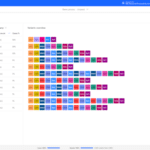Updated AI engine aims to boost productivity across business teams

Artificial intelligence is finding its way into many areas of business. But its value depends on the quality of the training data and user prompts it receives.
Dynatrace is looking to address this with an update to its Davis AI engine that creates what it calls a 'hypermodal artificial intelligence', combining fact-based, predictive- and causal-AI insights with new generative-AI capabilities.
Generative AI assistant helps secure the cloud

Cloud security company Sysdig is launching a new generative AI assistant specifically designed to help with cloud security.
Whereas standard AI chatbots are designed to answer a specific question using a single large language model (LLM) and stateless analysis, Sysdig Sage uses a unique human-to-AI controller that mediates user interactions with LLMs to provide more advanced, tailored recommendations.
New tool uses AI to help ensure AI-generated content is fit for humans

Experts reckon that over 90 percent of internet content could be AI generated by the end of the decade. But we all know that AI isn't perfect; it can introduce biases and errors.
Checking material to ensure it's suitable for the target audience is therefore essential. User experience research platform WEVO is launching a new research tool, WEVO 3.0, to ensure that AI-generated products and experiences are well received by their target human audience.
How software-defined instrumentation is changing testing and measurement [Q&A]

The testing and measurement industry like any other is looking towards digital transformation projects, but it’s a sector that in the past has been slow to adapt.
Software-defined instrumentation looks set to change that and drive transformation efforts forward. We spoke to Daniel Shaddock, the co-founder and CEO of Liquid Instruments and a professor of physics at the Australian National University, to find out more.
Business IT model needs to change to cope with 'workquake'

A pandemic-induced shift to remote work, combined with relentless technological advances such as generative AI, has resulted in a 'workquake', causing a rapidly evolving landscape in which enterprises must adapt to new technologies, working practices, and business models without established procedures.
New research from Doherty Associates identifies a growing complexity avalanche for IT teams. Smaller teams, in particular, report an increase in the breadth and depth of tasks in addition to business-as-usual duties.
Open source supply chain attacks specifically target banking

Researchers at Checkmarx have detected several open-source software supply chain attacks that specifically target the banking sector.
These attacks use advanced techniques, including targeting specific components in web assets of the victim bank by attaching malicious functionalities to them. The attackers employed deceptive tactics such as creating fake LinkedIn profiles to appear credible and customized command and control centers for each target, exploiting legitimate services for illicit activities.
How AI and automation have helped adapt to changed customer behavior [Q&A]

We're continuing to feel the effects of the COVID-19 pandemic in many areas, not least in the impact that it’s had on consumer behavior.
In order to cope with the shift in the way that people interact with businesses many have turned to increased automation and use of AI. We spoke to Sateesh Seetharamiah, CEO of enterprise automation specialist Edgeverve, to find out more about these changes and what they mean for the longer term.
Over half of AI open source projects contain vulnerabilities

New research shows 52 percent of the top 100 AI open source projects on GitHub reference known vulnerable open source software packages.
The report from Endor Labs explores emerging trends that software organizations need to consider as part of their security strategy, and risks associated with the use of existing open source software (OSS) in application development.
Public ransomware victims increase 100 percent year-on-year

A new report from GuidePoint Security shows a startling 100 percent increase in publicly posted ransomware victims from Q2 2022 to the last quarter.
The study from the GuidePoint Research and Intelligence Team (GRIT) also shows a 38 percent increase in public victims compared to Q1 of this year.
Training makes critical infrastructure employees better at spotting phishing attacks

New research from security behavior change specialist Hoxhunt shows that 66 percent of active participants in security behavior training programs at critical infrastructure organizations detect and report at least one real malicious email attack within a year.
The report -- based on analysis of over 15 million phishing simulations and real email attacks reported in 2022 by 1.6 million people participating in security behavior change programs -- shows the effectiveness of training in making staff more engaged in organizational security.
71 percent of organizations may have been breached and not know it

A new survey of over 2,000 IT security analysts finds that 71 percent admit their organization may have been compromised and they don't know about it yet.
The study, from Vectra AI, details how analysts are being overwhelmed, as they receive 4,484 alerts on average per day, but can't cope with 67 percent of them. This leads 97 percent to worry that they'll miss important security events.
Data bias -- the hidden risk of AI and how to address it [Q&A]

Artificial intelligence is generally only as good as the data that it's trained on. However, when data is collected and used in the training of machine learning models, the models inherit the bias of the people building them, producing unexpected and potentially harmful outcomes.
We spoke to Matthieu Jonglez, VP, technology at Progress, to discuss the company's recent research around this topic and what organizations can do to reduce bias.
New Azure offerings help speed cloud migration

The cloud offers many benefits including scalability, cost savings, and flexibility, but the migration process isn't always an easy one.
Today at Microsoft Inspire the company is launching two new offerings aimed at making it easier for enterprises to migrate to Azure.
Microsoft introduces process mining to help drive business insights

Among today's announcements coming out of Microsoft Inspire is news that Power Automate Process Mining will become generally available to all channels on August 1st.
Using AI it will enable organizations to easily understand what is happening across their business, maximize process insights, use out-of-box recommendations to reduce the complexity of processes, transform operations, and drive continuous process improvement with automation and lowcode apps.
Don't walk the walk when creating passwords

When you're creating a new password in a hurry it's tempting to choose keys that are adjacent to each other on the keyboard. In security circles this is known as a 'walk pattern'.
Of course this is horribly insecure but it's also worryingly common. New research from Specops has analyzed an 800 million password subset of its larger Breached Password Protection database to find the top keyboard walk patterns in compromised password data.
Ian's Bio
Ian spent almost 20 years working with computers before he discovered that writing about them was easier than fixing them. Since then he's written for a number of computer magazines and is a former editor of PC Utilities. Follow him on Mastodon
© 1998-2025 BetaNews, Inc. All Rights Reserved. About Us - Privacy Policy - Cookie Policy - Sitemap.
